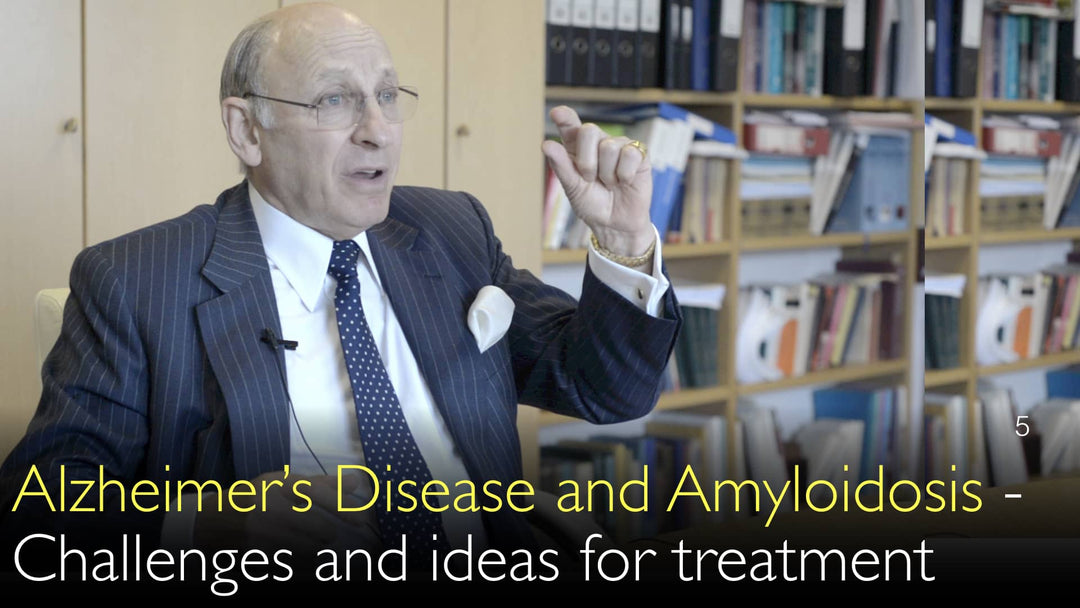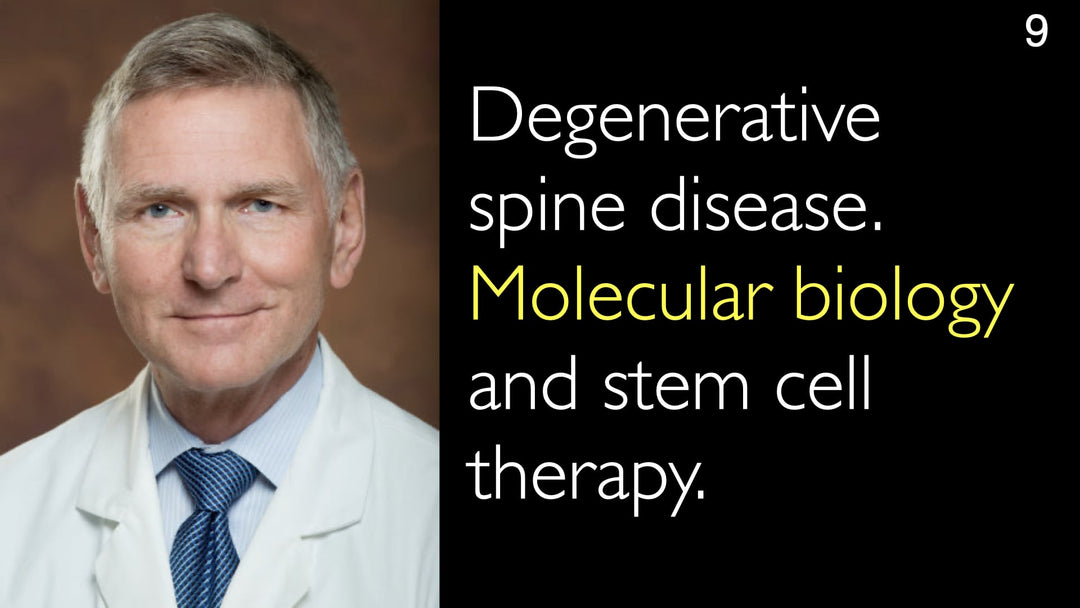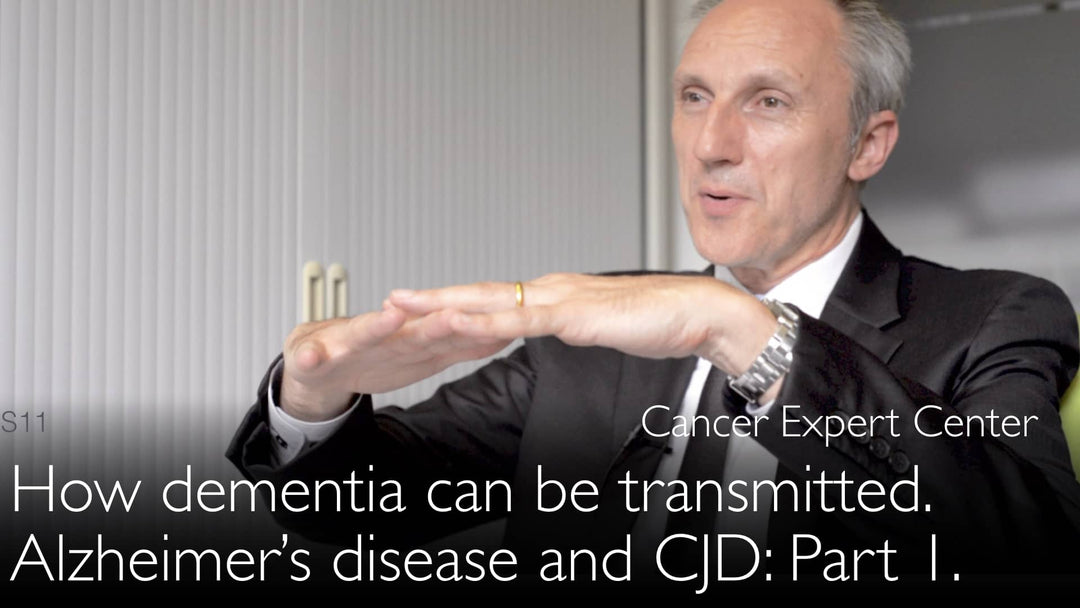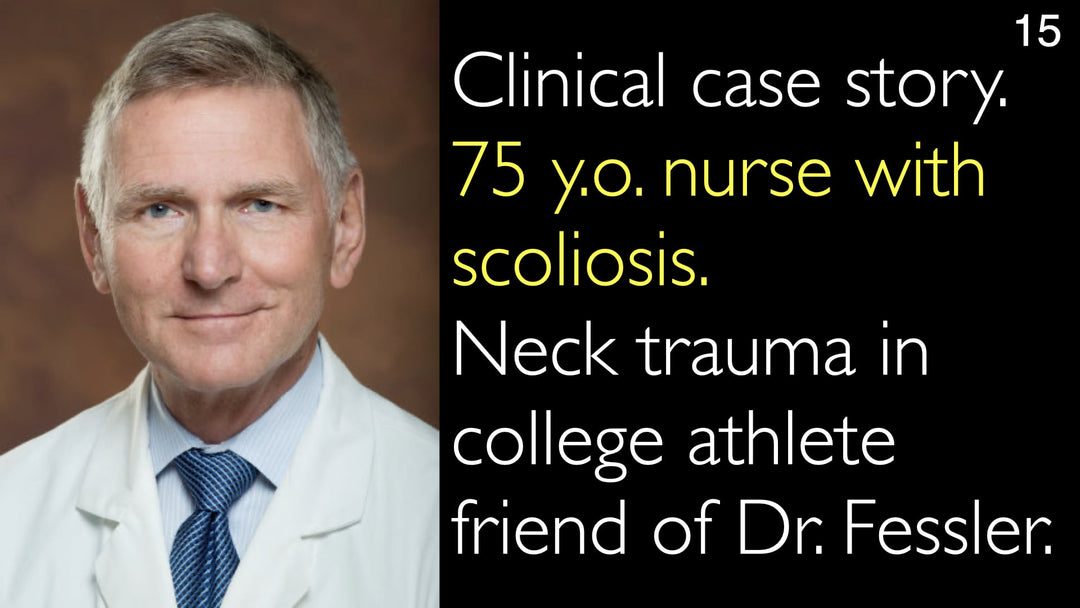Dr. Mark Pepys, en ledande expert på behandling av amyloidos, förtydligar de avgörande skillnaderna mellan systemisk amyloidos och Alzheimers sjukdom. Han påpekar att Alzheimers sjukdom kännetecknas av mikroskopiska amyloidavlagringar i hjärnan, medan systemisk amyloidos innebär omfattande, organspecifika avlagringar. Dr. Pepys belyser varför förväxling av dessa två tillstånd kan vara kliniskt riskfyllt. Han presenterar sin nya behandlingsmetod, som syftar till att avlägsna serum amyloid P-komponent (SAP) från hjärnan. En kommande klinisk prövning kommer att utvärdera om detta tillvägagångssätt kan bromsa progressionen av Alzheimers sjukdom.
Förstå amyloid vid Alzheimers sjukdom kontra systemisk amyloidos
Hoppa till avsnitt
- Nyckelskillnader mellan Alzheimers och amyloidos
- Betydelsen av en korrekt diagnos
- Amyloidets roll i Alzheimers patogenes
- Ny behandlingsmetod som riktar sig mot SAP
- Kommande klinisk prövning för Alzheimers
- Fullständig transkription
Nyckelskillnader mellan Alzheimers och amyloidos
Alzheimers sjukdom och systemisk amyloidos är två helt olika tillstånd. Dr. Mark Pepys, MD, framhåller att vid Alzheimers finns mikroskopiska amyloidplack i hjärnvävnaden. Den totala mängden amyloid i en Alzheimershjärna är minimal, endast cirka 100 milligram. Som skarp kontrast innebär systemisk amyloidos omfattande amyloidavlagringar i organ som levern, där det kan ackumuleras upp till 5 kilogram.
Placeringen och karaktären av avlagringarna skiljer sig också avgörande. Vid Alzheimers finns amyloid som små extracellulära plack sida vid sida med intracellulära neurofibrillära trassel. Vid systemisk amyloidos förekommer avlagringarna i organvävnader och blodkärlsväggar, men inte i hjärnparenkymet. Dr. Anton Titov, MD, och Dr. Mark Pepys, MD, diskuterar varför dessa skillnader är avgörande för korrekt diagnos och lämpliga behandlingsstrategier.
Betydelsen av en korrekt diagnos
Korrekt sjukdomsterminologi är avgörande för effektiv patientvård. Dr. Mark Pepys, MD, varnar för den farliga sammanblandningen av termer som "amyloidos" över olika sjukdomar. Att kalla Alzheimers, Parkinsons eller Huntingtons sjukdom för "amyloidos" skapar klinisk förvirring, eftersom varje tillstånd har distinkt patofysiologi och kräver helt olika behandlingar.
Denna precision är särskilt viktig vid systemisk amyloidos. Att missta ärftlig amyloidos för AL-amyloidos kan leda till att patienter som inte behöver det får toxisk cytotoxisk kemoterapi. Dr. Mark Pepys, MD, betonar att diagnos på molekylär nivå är essentiell. Behandlingsbeslut måste baseras på en precist identifierad amyloidproteintyp och dess underliggande orsak.
Amyloidets roll i Alzheimers patogenes
Sambandet mellan amyloidavlagringar och neurodegeneration vid Alzheimers är fortfarande inte fullt utrett. Dr. Mark Pepys, MD, påpekar att även om amyloid-beta-plack är en patologisk kännetecken för Alzheimers, är deras kausala roll i nervcellsdöd inte bevisad. Närvaron av amyloid korrelerar med Alzheimers sjukdom, men orsakar kanske inte direkt den kognitiva nedgången och demenssymtomen.
Genetiska bevis tyder på att amyloidvägen är involverad i sjukdomens patogenes. Mutationer i amyloidprekursorproteinet eller bearbetningsenzymer orsakar ärftlig tidigdebuterande Alzheimers genom att öka produktionen av amyloid-beta. Men den exakta mekanismen för nervcellsdöd förblir okänd. Liknande osäkerhet finns kring amyloidavlagringar vid typ 2-diabetes i bukspottkörteln, som kan vara biprodukter snarare än orsaker till sjukdomen.
Ny behandlingsmetod som riktar sig mot SAP
Dr. Mark Pepys, MD, har utvecklat en ny terapeutisk metod som riktar sig mot serum amyloid P-komponent (SAP). Detta normala blodprotein binder till alla amyloidavlagringar, inklusive de i Alzheimershjärnor. Hans läkemedel tar helt bort SAP från blodet och följaktligen från hjärnan och cerebrospinalvätskan.
Forskning avslöjar två övertygande mekanismer för denna metod. För det första kan avlägsnandet av SAP från amyloidavlagringar hjälpa till att rensa bort dessa patologiska strukturer från hjärnan. För det andra visar nya bevis att SAP är direkt toxiskt för cerebrala neuroner och orsakar celldöd genom apoptos. En preliminär studie på fem Alzheimerspatienter bekräftade att läkemedlet effektivt tar bort SAP från cerebrospinalvätskan. Djurmodeller visar att det även avlägsnar SAP från hjärnans amyloidavlagringar.
Kommande klinisk prövning för Alzheimers
En stor klinisk prövning kommer att testa denna SAP-riktade terapi för Alzheimers sjukdom. Finansierad av Storbritanniens National Institute for Health Research kommer studien att rekrytera 100 Alzheimerspatienter till en placebokontrollerad, dubbelblind prövning som varar i tre år. Denna forskning syftar till att avgöra om avlägsnandet av SAP kan påverka sjukdomsförloppet och olika kliniska mått.
Dr. Mark Pepys, MD, förklarar att medan tidigare antikroppsmetoder som riktar sig mot amyloid-beta i stor utsträckning har misslyckats, tar hans metod ett annat tillvägagångssätt. Genom att rikta sig mot SAP istället för amyloid direkt kan behandlingen övervinna tidigare begränsningar. Om framgångsrik kan denna terapi potentiellt stoppa Alzheimers progression i tidiga stadier, vilket ger betydande fördel även om den inte kan vända existerande nervskador.
Fullständig transkription
Dr. Anton Titov, MD: Hur skiljer sig Alzheimers sjukdom och amyloidos åt? Vad har de gemensamt?
Dr. Mark Pepys, MD: Alzheimers sjukdom är en mycket annorlunda sjukdom jämfört med systemisk amyloidos. Vid Alzheimers finns amyloidavlagringar i hjärnvävnaden, något som aldrig förekommer vid systemisk amyloidos. Vid systemisk amyloidos kan amyloid avlagras i hjärnans membran eller i blodkärlen som försörjer hjärnan, men inte i hjärnsubstansen själv.
Vid Alzheimers är amyloidavlagringarna mikroskopiskt små. Den totala mängden amyloid i hjärnan är bara några milligram, kanske 100 milligram. Det är absolut minimalt!
Hos personer med kliniskt manifesterande Alzheimers finns endast en liten mängd amyloid. Det är mycket, mycket lite amyloid. Det finns små mikroskopiska plack – patologer kallar dem amyloidavlagringar.
Det finns också andra onormala proteinstrukturer, så kallade neurofibrillära trassel. De är inte äkta amyloid, men liknar det i hur proteinerna viks. Dessa är de neuropatologiska kännetecknen för Alzheimers, men de är mycket små i mängd.
I levern hos någon med systemisk amyloidos kan det finnas 5 kilogram amyloid. Det är en helt annan situation.
5 kilogram kontra några milligram? Ja. Jag kallar inte Alzheimers för "amyloidos". Inom medicinen är det mycket viktigt att använda rätt termer.
Neurovetare, biokemiker och biofysiker som arbetar i området är ofta inte kliniska läkare och använder ord löst. Detta är ett kontroversiellt område. Som klinisk läkare som tar hand om patienter spelar det verkligen roll vad man kallar saker.
Man använder ett specifikt ord som en diagnos med en given behandling. Om man sedan använder samma ord för någon med en annan sjukdom som kräver helt annan behandling, blir det en katastrof!
Tyvärr är det nu modernt att använda dessa termer brett. Detta inflytande från grundforskningen har i viss utsträckning spillt över i den kliniska världen. Folk kallar Alzheimers, Parkinsons och Huntingtons sjukdomar för "amyloidos", eftersom de på molekylär nivå delar vissa likheter.
De har alla onormala proteinstrukturer, men de är inte amyloidos. Vid Huntingtons finns onormala ämnen i cellkärnan. Vid Parkinsons finns amyloid i cellens cytoplasma. Vid Alzheimers finns amyloid utanför cellerna.
Detta är välkänt. Amyloidos är något annat. Alla dessa sjukdomar är helt olika. De skiljer sig mer åt än att jämföra längdhopp på jorden, månen och Mars – olika atmosfär, annan gravitation.
Miljön inuti kärnan, i cytoplasman och utanför cellen är helt annorlunda. Det är mycket viktigt att inte blanda ihop dessa saker. Att göra det är mycket farligt.
Även inom systemisk amyloidos kan man göra misstag. Om man misstar ärftlig amyloidos för AL-amyloidos kan man ge toxisk cytotoxisk kemoterapi till patienter som inte behöver det. Kemoterapi för AL-amyloidos kan faktiskt döda patienter, eftersom den är mycket giftig.
Andra patienter med amyloidos kan ha en genmutation och behöver inte cytotoxisk kemoterapi. Att göra detta misstag är en katastrof.
Dr. Anton Titov, MD: Som kliniker är vi mycket medvetna om att använda ord korrekt. Det är mycket viktigt. Det understryker vikten av en korrekt och fullständig diagnos. Att bara säga "amyloidos" eller "cancer i detta organ" räcker inte. Diagnosen måste vara exakt på molekylär nivå.
Dr. Mark Pepys, MD: Absolut! Det gör en enorm skillnad för behandlingen! Verkligen! Problemet är att många nu går ner på molekylär nivå och säger att alla dessa sjukdomar kännetecknas av felvikta proteiner som aggregerar på ett visst sätt.
Visst, det stämmer. Men vi vet inte, särskilt vid Alzheimers, om amyloidplacken har något med neurodegeneration att göra.
Dr. Anton Titov, MD: Vad får en att bli dement vid Alzheimers? Vad får en att förlora sin kognitiva funktion? Det är död av nervceller. Ingen vet säkert vad som får dessa nervceller att dö. Att amyloid finns där är en intressant patologisk association. Det korrelerar med sjukdomen, men det betyder inte att det orsakar den.
Dr. Mark Pepys, MD: Vi vet att proteinet som bildar amyloidfibriller vid Alzheimers kallas amyloid-beta. Det kommer från ett prekursorprotein på ytan av nervceller. Prekursorproteinet klyvs, och ett litet fragment frigörs, aggregerar och bildar amyloidavlagringar.
Vi vet att vägen från amyloidprekursorproteinet till A-beta och amyloidfibriller är relaterad till Alzheimers patogenes. Det finns sällsynta familjer med mutationer i det proteinet eller i enzymerna som bearbetar det. Dessa mutationer ökar produktionen av A-beta-fragmentet, och patienterna får ärftlig tidigdebuterande Alzheimers. Så den vägen är viktig. Men exakt vad som dödar nervcellerna är fortfarande okänt.
Jag anser för närvarande varken Alzheimers eller andra sjukdomar vara en direkt följd av amyloidavlagringar. Typ 2-diabetes är ett annat exempel där det alltid finns amyloid i bukspottkörteln, som är ett målorgan för sjukdomen.
Vi vet inte om dessa lokala amyloidavlagringar orsakar sjukdomen eller inte. De är mycket små i storlek och mängd och kan bara vara biprodukter eller biverkningar. Vi vet inte.
Dr. Anton Titov, MD: Det var det första att säga. Låt oss återgå till dina förslag för behandling av Alzheimers.
Dr. Mark Pepys, MD: Min ursprungliga idé var att få kroppen att ta bort amyloidavlagringarna i hjärnan vid Alzheimers genom att avlägsna SAP (serum amyloid P-komponent) med vår småmolekylära medicin. Jag anser fortfarande att det är en mycket bra idé. Vi håller på att starta en klinisk prövning för att testa just denna terapi vid Alzheimers.
Tanken var att hitta en behandling som får amyloidet att försvinna från hjärnan, så att Alzheimers upphör att fortskrida. Eller att patienter blir mirakulöst bättre, vilket är osannolikt när hjärnceller redan har förlorats. Man kan inte ersätta döda neuroner, men man kan åtminstone stoppa sjukdomsförloppet i ett tidigt stadium. Det skulle ha en dramatisk inverkan på Alzheimers kliniska bild. En behandling som avlägsnade amyloid skulle också bevisa hypotesen om amyloidavlagringarnas skadlighet.
Men hittills har ingen lyckats med en sådan behandling.
Dr. Anton Titov, MD: Det har gjorts försök med antikroppar mot A-beta, som teoretiskt skulle kunna göra i hjärnan vad du har åstadkommit vid systemisk amyloidos i andra organ. Miljarder dollar har spenderats på kliniska prövningar för Alzheimers.
Dr. Mark Pepys, MD: De har ännu inte haft framgång. Det finns några möjligen lovande resultat nyligen, där patienter med lindrig Alzheimers som behandlas tidigt kan visa förbättring med lämplig antikroppsbehandling. Men det är långt ifrån bevisat.
De flesta behandlingarna har misslyckats på grund av brist på effekt eller toxicitet. Min metod är annorlunda.
Jag har en medicin som tar bort SAP nästan helt från blodet. SAP produceras endast i levern. Det finns i hjärnan i mycket låg koncentration, ungefär en tusendel av blodets koncentration. Att avlägsna allt SAP från blodet får det att försvinna helt från hjärnan.
Vi har gjort en preliminär studie på 5 Alzheimerspatienter som fick vår medicin i tre månader. Den tog bort allt SAP från cerebrospinalvätskan (CSF), som omger hjärnan.
Nyligen utförde vi djurförsök med en Alzheimersmodell som har amyloid i hjärnan. Vi visade att vår medicin avlägsnar allt SAP från dessa amyloidavlagringar. Det finns starka bevis för att medicinen kommer att vara effektiv för att biokemiskt göra vad vi vill.
Vår medicin avlägsnar SAP från amyloidavlagringarna i hjärnan. Det är en väg att skapa en behandling för Alzheimers. Det är en gammal idé för mig – jag har haft den i 20 år. Nu står vi på gränsen till att testa den.
Men under tiden har flera andra laboratorier visat att humant SAP är toxiskt för cerebrala neuroner.
Dr. Anton Titov, MD: Ibland odlar man cerebrala neuroner i vävnadskultur och exponerar dem för humant SAP. Då dör neuronerna. När jag först såg dessa studier var de mycket intressanta, men när jag läste dem var jag mindre övertygad.
Dr. Mark Pepys, MD: Jag var inte övertygad om renheten hos de kommersiellt köpta protein de använde. Vem vet hur de behandlats? Så jag var ganska skeptisk.
Logiskt sett, varför skulle ett normalt blodprotein döda hjärnceller? Det verkar konstigt! Men faktum är att vi kan upprepa dessa observationer. De är robust reproducerbara. Humant SAP är skadligt för cerebrala neuroner. Neuroner dör vid Alzheimers.
SAP binder till neuroner, kommer in i cellerna och cellkärnorna, och cellerna dör sedan genom apoptos. Vi känner inte till de exakta molekylära mekanismerna än, men det är en reproducerbar observation med högt renat farmaceutiskt SAP, som vi unikt har i vårt laboratorium.
Detta är nu en övertygande andra motivering för vår medicin att avlägsna detta protein från blodet och hjärnan. Min nuvarande hypotes är att SAP bidrar till bildandet och beständigheten av amyloidplack vid Alzheimers och att det är skadligt för hjärnan.
Vid Alzheimers har man dessa plack av amyloid och neurofibrillära trassel, allt belagt med SAP. Det finns en onormalt ökad mängd SAP i hjärnan hos Alzheimerspatienter. SAP är dåligt för hjärnan. Låt oss bli av med det!
Det är tanken bakom vår kliniska prövning, som nu finansieras av National Institute for Health Research i Storbritannien. Vi kommer att studera 100 Alzheimerspatienter i en placebokontrollerad dubbelblind prövning under tre år. Vi kommer att se om det har någon inverkan på allt som möjligen kan mätas vid Alzheimers. Det är vad vi gör.








